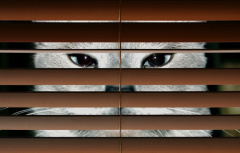
The film “Cats & Dogs” clearly demonstrates that our pets need to be checked not only for fleas and ticks, but also for all sorts of spy devices. But that's just a film, but is it really possible to turn a purring ball of fur into a secret service agent?
Let's first look at the representatives of the opposite camp—dogs. They've long worked in the security field. Customs services, drug enforcement agencies, and rescue services—none of them would be able to function without dogs. Meanwhile, cats wander about on their own, occasionally dropping in for more food (or to poop in a litter box or slipper). Except, in Yuri Kuklachev's work, where felines engage in socially significant activities. The rest of the cats are narcissistic, lazy, and egotistical parasites on society.
What potential! It can crawl anywhere, climb anywhere, and it has brains—you can't take that away. No, such a thing can't go to waste. That's roughly how CIA officers reasoned in the early 1960s, when they conceived the Acoustic Kitty project. From the name itself, one could guess that the test cat would be eavesdropping on the communications of a potential adversary, that is, the USSR. No, they weren't trying to teach the cat human language and then gift it to the General Secretary of the CPSU Central Committee. Things turned out much more grim (for the cat).
The CIA's Science and Technology Directorate was responsible for equipping and training the cat. It was their specialists who discovered a way to transform the animal into a living eavesdropping device. I recommend cat owners and lovers stop reading this article when they reach the description of the manipulations performed on the cat. The cat endured some rather unpleasant surgeries. He would probably have preferred daily surgical castration to all of this. The transmitter and batteries were implanted inside the animal, and the antenna ran through its tail. The animal's brain also had to be slightly… modified to prevent it from feeling hunger. This was necessary because, when hungry, the animal would forget its duty to its homeland and begin searching for food. After the surgery, the cat was force-fed to prevent it from dying of exhaustion.
The cat's service with the CIA was short-lived. After training, he was released onto a lawn near the Soviet embassy in Washington… and a few minutes later, he was fatally struck by a passing taxi. The project cost $20 million. And that's not today's U.S. Treasury bills, but real money. Experts from the U.S. National Security Archive agree that the cat wouldn't have lasted long after what happened to him.
Former CIA officer Victor Marchetti told reporters, “They literally cut him in half, stuffed all these devices inside, and stitched him back together. They created a monster.”
The tragic story of the spy cat ended rather happily for the project's creators. Their work was rewarded. CIA leadership noted: “The work accomplished reflects the enormous contribution of our employees, whose energy and imagination can serve as an example to all scientific pioneers.”
Coincidentally, the year the Acoustic Kitten project failed, the British film The Spy with the Cold Nose was released, starring a dog “equipped” to spy on the “evil empire” (that's the USSR, again, for those unfamiliar). Sometimes, after all, it's worth leaving fiction on the sidelines.





